College Admissions: What’s Your Pie Chart?
It’s perfectly normal to worry about how your college application will be received by the admissions board, but today’s students may need to worry about this more than their predecessors due to the current coronavirus crisis. The abrupt switch to online courses can have stark impacts on your academic resume, especially if you have trouble adjusting or lack access to resources that may help.
As a student, it’s important to take the time to review your application and assess where it stands when judged against your peers – now more than ever. By evaluating your strengths and weaknesses, you can adjust your focus and your academic course to compensate for these strenuous circumstances.
Use MEK Review’s pie chart system to help you determine where an admissions officer may see flaws, and then use our best tips to counteract the coronavirus’s negative effects on your academic transcript.
What’s Your Pie Chart?
If you want to review your college application objectively, through the eyes of an admissions officer, we like to recommend our simple “pie chart” approach.
Below, you’ll see the factors that determine whether a college or university sends you an exciting thick acceptance packet or a painful, short rejection letter. Colleges look at everything from your GPA to your extracurricular activities to the state and school you’re from.
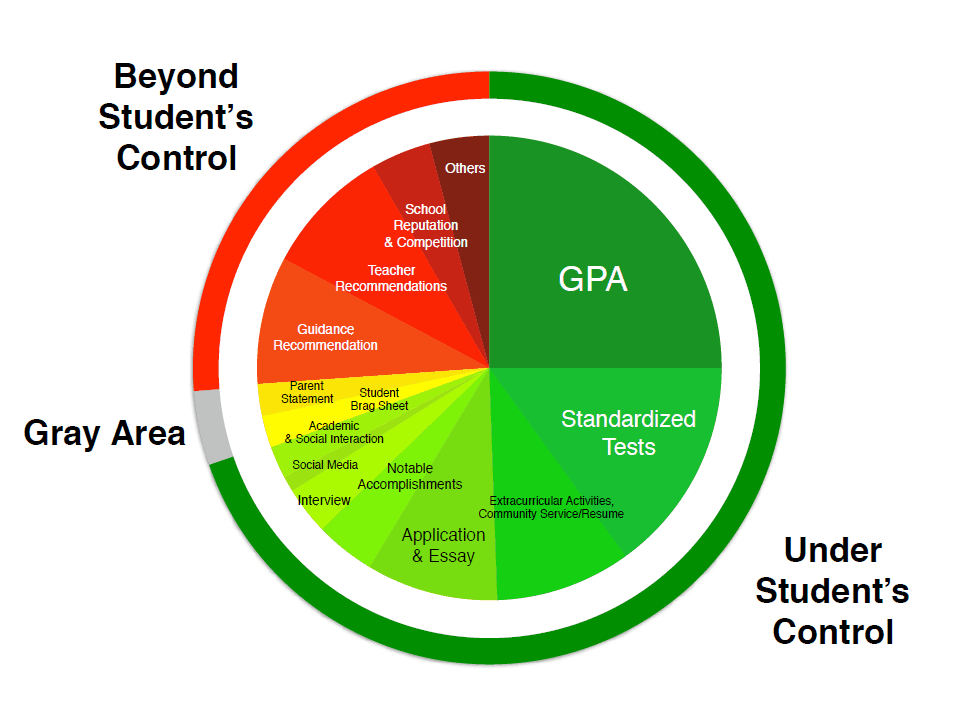
The red section of the pie chart shows the factors that are beyond your control. The gray section shows the factors that are somewhat within your area of control.
At first, it might be frustrating to look at the chart and see that almost 1/3 of factors appear to be fully or somewhat out of your control.
However, we advise you to focus on the green section, featuring the items that are within your control. To successfully gain admission to your dream school, you need to have a strong understanding of your strengths and weakness on a college application, and more importantly, which colleges are suitable for those strengths and weaknesses.
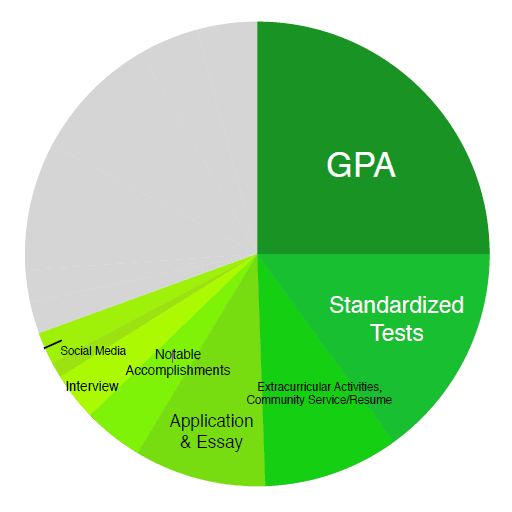 Note: the two largest sections of the pie are the ones that are completely within your control, including your GPA and college admission test scores like the SAT, ACT, or SAT Subject tests.
Note: the two largest sections of the pie are the ones that are completely within your control, including your GPA and college admission test scores like the SAT, ACT, or SAT Subject tests.
Smaller but still significant factors within your control are: your extracurricular activities, accolades, and a college application essay that showcases your interests, talents, and character.
Then there are yet smaller areas that allow admission officers to learn more about you, such as an interview process (for more competitive schools) or your social media presence — yes, some colleges check your public Instagram, Facebook, or Twitter accounts!
The Ideal Admissions Pie Chart
In taking all these “green” factors into account, you have four main areas within your college admissions control: GPA, Test Scores, Activities, and Character.
Here is an example of that pie chart:
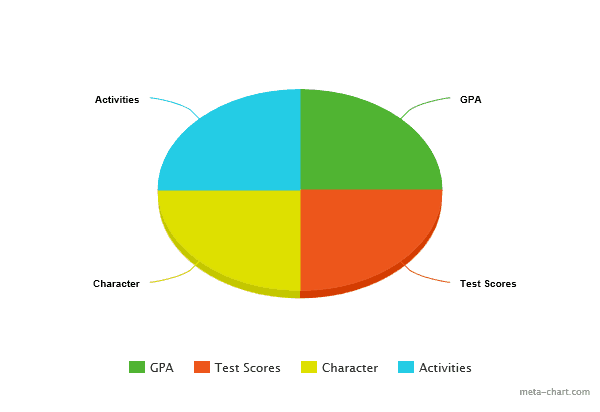
Let’s say your pie chart looks like this. You have a strong GPA, stellar test scores, a great admission essay that demonstrates your character, and you practice a range of athletic, artistic, and charitable activities. You may think that this is the perfect pie chart to have; one that a college can’t resist. Indeed, you would be a competitive candidate.
However, the truth is, most of us don’t have “dream” pie charts like this. Most of us are stronger in some areas and weaker in others. That’s okay! Most colleges and universities care more about one aspect compared to the others.
The GPA-Strong Pie Chart
Here’s another example.
Is your pie chart like this?
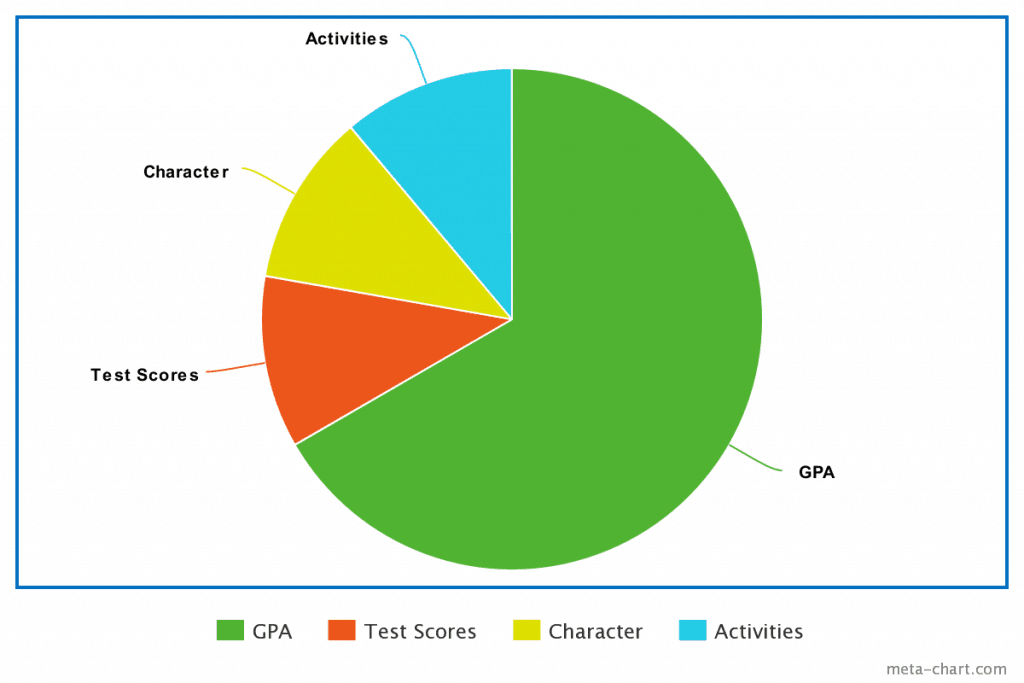
Do you have a really strong GPA, but you’re a bad test-taker? Do you feel like your application doesn’t stand out, and your admission officer won’t have a clear idea of who you are?
Don’t worry. First of all, grades are the number one factor that schools look at to determine acceptance.
Plus, if you know this is your pie chart, you can focus on taking test prep courses to drastically improve your scores in a matter of months. Additionally, focusing on writing an amazing college application essay will help to showcase your character and highlight which strengths you bring to the table.
The Activities-Strong Pie Chart
What if your pie chart looks like this?
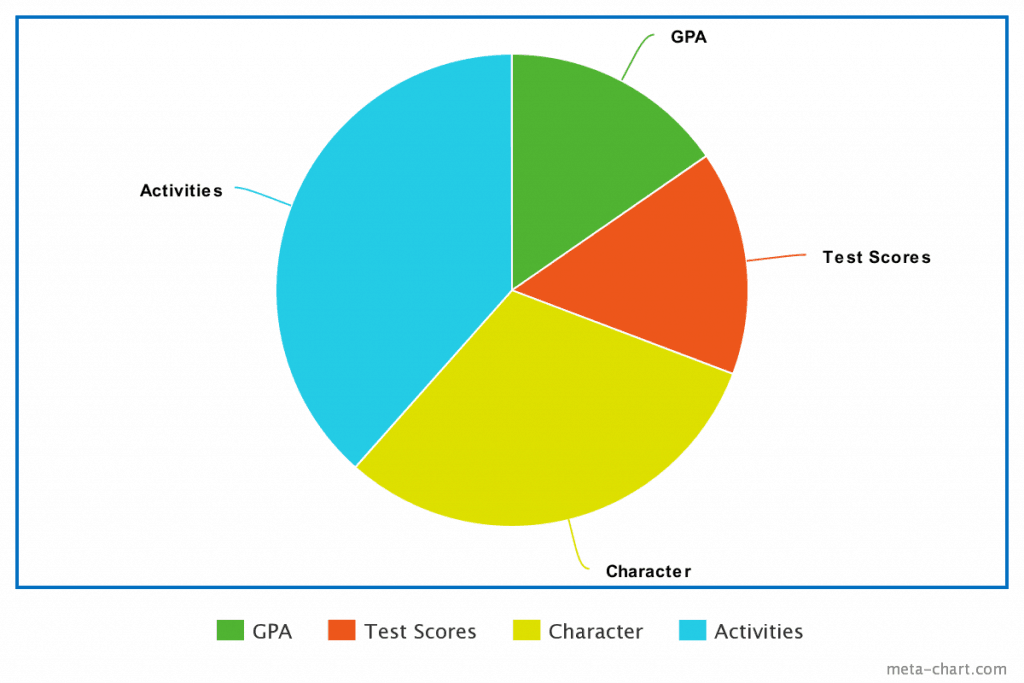
Okay, so your GPA and your test scores aren’t the best.
However, you’ve won two national art contests. Maybe you have a room full of dance trophies and even organized a dancing competition fundraiser for the underprivileged. Maybe you took your basketball team to state finals. You have strengths that go beyond just the classroom, but you’re worried that your grades will keep you from your dream school.
If this is your pie chart, you may need to look at liberal arts colleges that will value your artistic talent.
Maybe you can look into Service Academies that will value your discipline, character, and athleticism. Additionally, you can register for a test prep class to boost your test scores and compensate for your average or below average GPA.
The Scores-Strong Pie Chart
What about this pie chart?
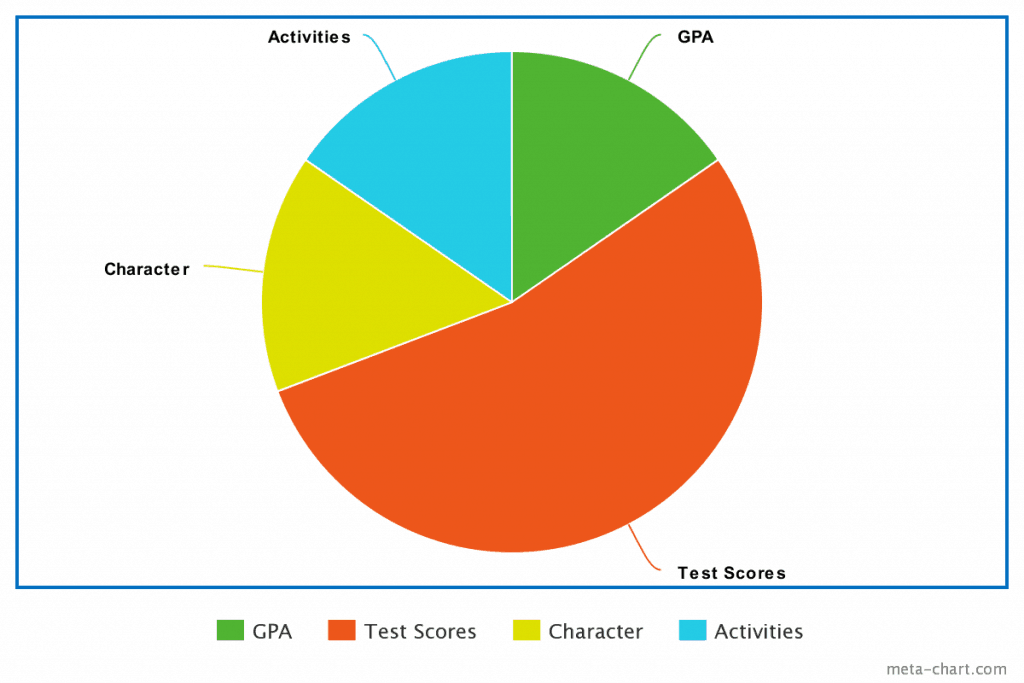
Are you an amazing-test taker? Did you work really hard and hit the high 1500s on your SAT and a 36 on the ACT? Despite all that, is your GPA is somewhat less than impressive, because you went through a rebellious phase during your sophomore year?
We already mentioned earlier that your GPA is the number one factor in college admissions. You may suddenly be worried that all your hard work during SAT/ACT Prep was for nothing!
Wait just a second! There are still plenty of schools for you – colleges that will appreciate your ability to score in the top percentile of test takers and answer complex questions on a timed test. Plus, you can focus on maximizing your admission essay to show your true hard-working, dedicated personality.
The GPA-and-Scores-Strong Pie Chart
What about this pie chart?
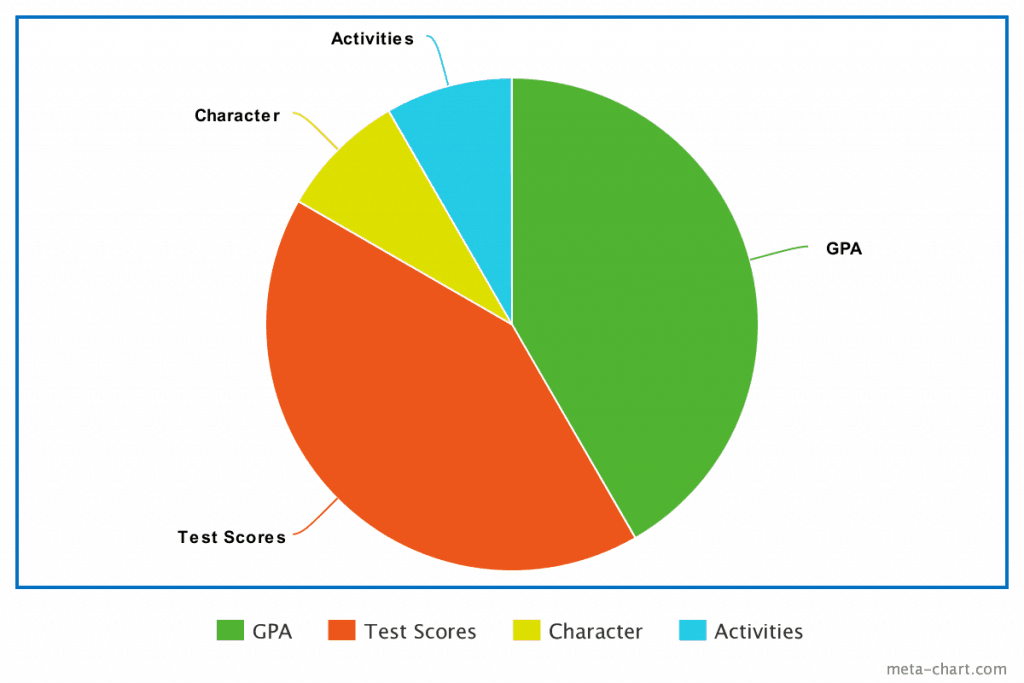
If you have this pie chart, you may not be worried at all.
You’re at the top of your class, you aced your SAT or ACT admissions test, and you’re about to be named salutatorian of your high school.
However, colleges are still going to look at your extracurricular activities and character. Do you give back to your community and therefore will one day give back to your college? Do you have passions, interests, and initiatives that take you out of the library, meaning you will also equally participate and contribute to your future university campus?
You may start to sweat that you’re not well-rounded enough for the most competitive schools.
That’s okay! If you’re an upperclassman beginning your college applications, focus on the schools that will value your intellect the most.
Plan on using your application essay to highlight other aspects of your personality that will convince an Ivy League school that you will be an active, productive member of their student body. If you’re a sophomore or incoming junior, it’s not too late to amp up your extracurricular activities.
Admission officers have repeatedly said that they care more about quality than quantity. It’s not about doing 1,000 volunteer hours or 10 after-school programs. It’s about picking one or two things that you can really contribute to in a meaningful way and which align with your academic or career interests.
The Character-Strong Pie Chart
Finally, what about this pie chart?
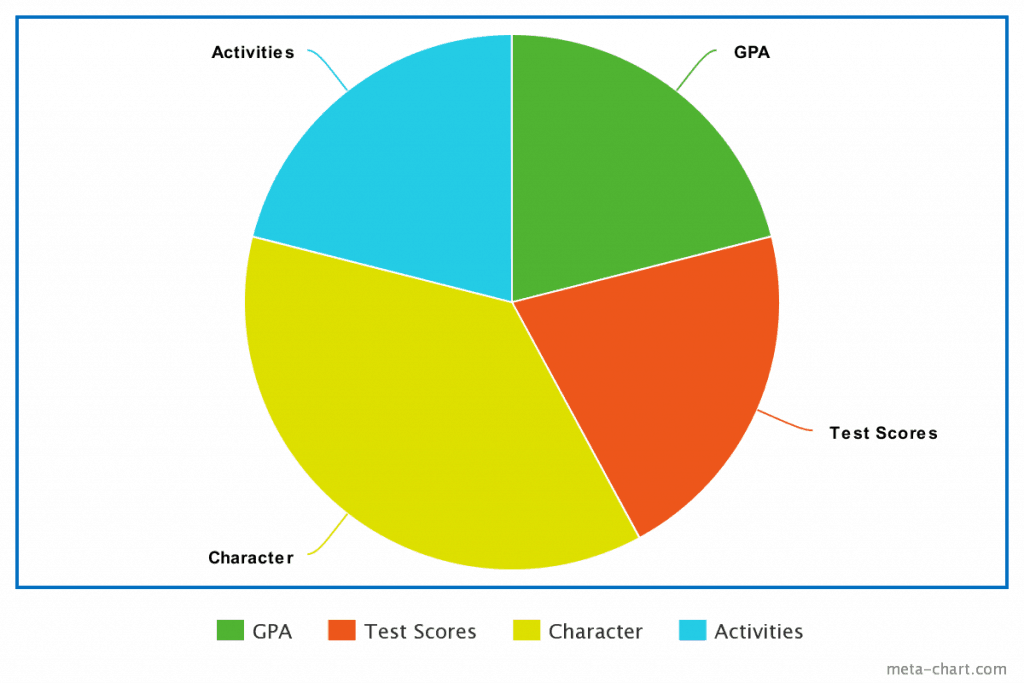
Your test scores are okay, you have a B- GPA, and you were in the marching band. Nothing alarming that would be a red flag, yet nothing remarkable.
All in all, you may be worried that you just don’t excel enough in any individual area to get the attention of a top university.
However, you have one thing that others don’t: an amazing character. Maybe you’ve volunteered all of your life. Maybe you’ve overcome tremendous obstacles. Maybe you’re the first person in your family to graduate high school.
Focus on applying to the schools that will appreciate your perseverance and integrity. Spend extra time on crafting a college application essay that highlights the most compelling aspects of your journey to where you are today.
Summing It Up
So ask yourself: which college admissions pie chart am I?
Reflect on your grades, activities, accomplishments, test scores, and contributions to your community.
Once you know your pie chart, you can use that information strategically.
If you arrive at your realization during freshman and sophomore year, redirect your energies and priorities to boost select aspects of your pie chart that may lag behind the others.
On the other hand, if you are an upperclassman, you can focus on finding the right colleges, writing a standout application essay, and making the right decisions in your last two high school years to shine your application in the strongest light.
Next Steps
Are you still not sure which pie chart fits you?
That’s okay! MEK Review will help you figure it out.
Explore our Roadmap to College programs, our one-on-one program that guides you through the entire admissions process, carefully designed to help you figure out your personal strengths and weaknesses through the eyes of an admission officer.
Do you know your pie chart, but are unsure about which next steps to take?
Take advantage of our resources:
- Need better test scores? Dive into our prep courses for SAT and AP Exams. Or try a free practice test!
- Need a higher GPA? Explore MEK Learning Circles, High School Honors, and tutoring options to help you fully master core subject areas and learn powerful studying habits.
- Need help figuring out how to tackle your pie chart? Schedule a consultation to speak with an expert counselor!
To find out more, contact us today!



